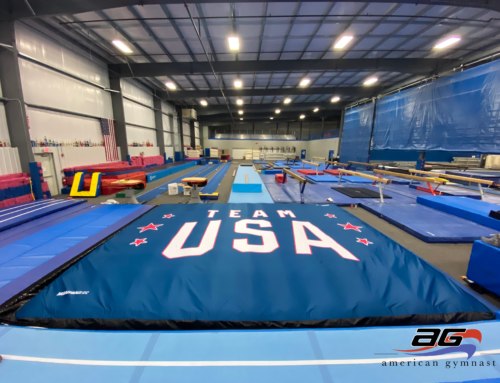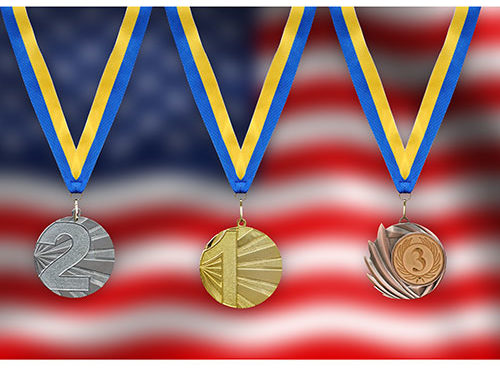With so much hype surrounding the American and Russian women’s teams – which have split the last two world team titles and are expected to battle for gold in London – it’s easy to forget that the defending Olympic women’s team champions are still the Chinese. Perhaps it was the inspiration of a home Olympic Games that raised the level of gymnastics in China during the 2005-2008 quadrennium. Or perhaps it was just the perfect combination of specialists on one team that seemed so ideal for the three-up-three count team finals format. Or perhaps there was simply something magical in the air that night in Beijing that allowed this team – which so many of us had revered for years but cringed when the pressure was on – to suddenly deliver peak performances in an Olympic Games like we’d never seen them do. Regardless of the reasons, there’s no denying the fact that those six young Chinese women – some of whom appeared so young we questioned their ages – constituted the best women’s team in the world that historic evening in Beijing, on which the Chinese women won their first Olympic team title ever.
Four years later, this team finds itself back in the same role it played many times throughout the 1990’s and early 2000’s – as a likely candidate for the Olympic bronze medal amongst the four most powerful teams in the world, but an unlikely contender for the gold unless some serious unforeseen events occur. Interestingly, the current Chinese team bears some striking similarities to the American women’s team that it battled with for gold on that memorable night four years ago. Just as is the case for the current American women’s Olympic mix, five members of the six-woman Chinese squad from Beijing are attempting to make repeat appearances at the Olympic Games this summer in London. While none of them are of the same Olympic champion caliber they were four years ago, none can be completed removed from the discussion either.
One of those five returning Olympians is Cheng Fei, who, like her Olympic teammates Jiang Yuyuan, He Kexin, Yang Yilin, and Deng Linlin, can probably remember that golden night in Beijing like it was yesterday, but has struggled to regain her world class form ever since. The three-time world vaulting champion (2005-2007) and former world floor champion (2006) is the Chinese equivalent of American Alicia Sacramone, in that both were two of the world’s best vaulters and tumblers between 2005-2008 (and probably of all-time), both are quite strong on beam, and both no longer train or compete on the uneven bars. Like Sacramone, who tore her Achilles tendon in October of last year, Cheng is also battling injuries and Mother Nature to return to the Olympic Games well into her 20’s. Both of these former vaulting adversaries will be 24 years old at the time of the Olympics in London.
Cheng competed at the 2009 Chinese Nationals and, despite not showing all of her signature world-class skills on floor and vault, still looked quite good. But Cheng’s body was clearly changing, and ongoing problems with an Achilles tendon and a reinjury of her right knee took her out of competition for the remainder of 2009 and 2010. Many of us thought we had seen the last of this former floor and vault phenom, but she reemerged at the 2011 Chinese Nationals, again looking noticeably heavier than she did in her hey-day, but still capable of performing a couple of strong vaults. Although her floor routine was quite watered down compared to what she used to perform, it was clear she was regaining her health and tumbling ability. Continued problems with injuries kept her from competing in the 2011 World University Games as she initially intended, but when she recently won the vault title at the Zibo World Cup last weekend, it became evident that her comeback is indeed for real. Speculation about where Cheng might possibly fit into this summer’s Chinese Olympic team has now begun to circulate.
One would think that the most successful vaulter of all time should have no trouble making the Chinese women’s team, particularly given the team’s current weakness on this event compared to the Americans and Russians. But Cheng isn’t currently performing either of the signature vaults that catapulted her to world championship gold three times in a row – the “Amanar” (Yurchenko 2 ½ twist) or her very own “Cheng” (round-off half-on handspring rudi off). Instead, she’s performing the standard DTY and a laid-out Podkopayeva, vaults which many of the world’s top twelve teams would be pleased to have in their lineup, but which are nothing more than status quo for the world’s top four squads.
As vault is one of the biggest areas where the Chinese need to improve if they hope to challenge the Americans and Russians, a big vault like the two that Cheng was capable of several years ago would be the most powerful weapon this team could possibly conjure up, and would undoubtedly launch this former champion onto her third consecutive Olympic team.
The DTY she performed at last weekend’s Zibo World Cup was strong, but not powerful enough yet to throw an additional half twist. Her laid-out Podkopayeva was perhaps a little more promising, as she showed a little more rotation on this vault and landed more vertically. Although she needs a little more height on this vault as well, an additional full twist wouldn’t be all that difficult to imagine. The one she competed in 2011 was actually slightly better, as you’ll see below.
Cheng Fei Vault 2012 Zibo World Cup Event Finals
Cheng Fei Vault 2011 Chinese Nationals Event Finals
Similar to the Americans, the Chinese probably have about a dozen young women who are in contention for this Olympic team, and probably only two who are essentially locks – current world all-around bronze medalist Yao Jinnan and current world beam champion and world floor silver medalist Sui Lu. The three remaining spots are up for grabs, and could go to any of multiple combinations of gymnasts, including several of the returning 2008 Olympians, or Huang Qiushuang, Tan Sixin, Wu Liufang, Huang Huidan, Zeng Siqi, and others.
Time is running out for Cheng Fei to prove she’s as valuable to her team in 2012 as she was from 2004-2008. If she can come up with just one of her former world championship winning vaults – both of which are valued at an enormous 6.5 difficulty rating – a strong case could be made for her to make this summer’s Olympic team. Without these big guns in her arsenal, though, Cheng’s Olympic days are likely all in the past. Just as with the American Olympic selection process, this battle between the Chinese Olympic veterans and the younger rookies will be very exciting to see play out.



Leave A Comment